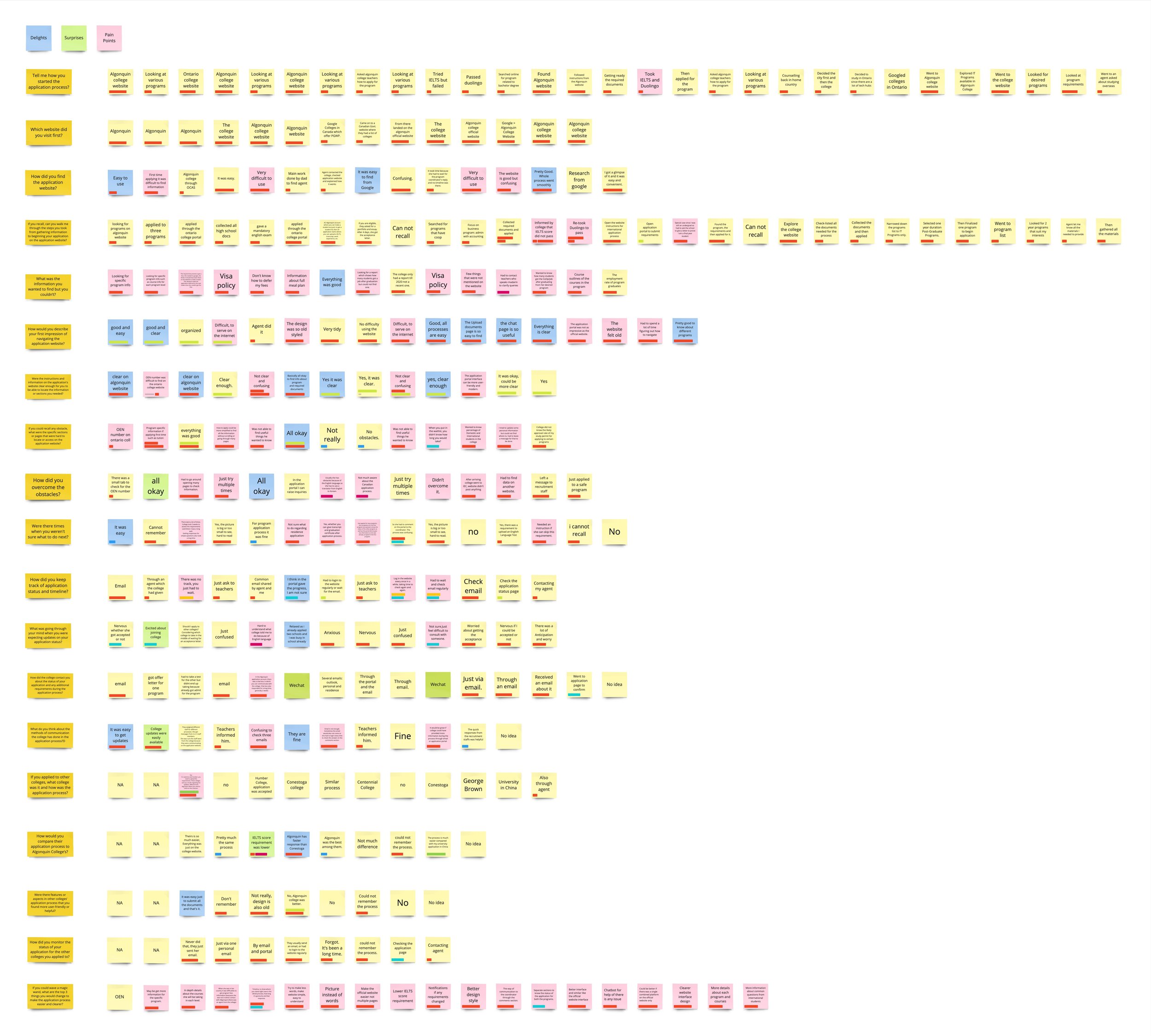Students Pathway to Higher Education: Examining Application Process Challenges

Role: UX Researcher
Category: Service Design
Tools: Google document, Miro, Figma
Skills: UX Research
💭 Project Background
As part of a six-student team from the Human-Centered Design Lab at Algonquin College, we were tasked with identifying the challenges in the onboarding process for new students. Our focus was on the difficulties encountered during the application process, recognizing it as a crucial step for prospective students embarking on their educational journey.
👩💻 My Role
In this study, my contributions included conducting user interviews and serving as the note-taker for every pair of participants. Additionally, I was involved in developing the findings and recommendations after collaborating with the team to analyze the interview data.
🎯 Project Goal
The objective of this study is to gather insights and formulate recommendations that will enhance the application process at Algonquin College, making it smoother for prospective students.
📝 Introduction
In today's world, where higher education plays a crucial role in career development, the journey towards it should be smooth and accessible. Yet, aspiring students often face obstacles, especially in navigating online application systems like the one used by Algonquin College. This process can be confusing and anxiety-inducing, particularly for first-time applicants. To address these challenges, we prompted a research question as follows:
What are the challenges faced by students during Algonquin College’s application process?
Our study delves into the experiences of students navigating the Algonquin College website and application portal, focusing on the journey from initial program research to application submission. We aim to uncover the challenges faced by students who have used these platforms in the last two years.
The ultimate goal is to identify improvements for the website and portal interface, enhancing clarity and ease of the application process. Our long-term vision is to develop a more student-centric, streamlined, and transparent application system, making the path to higher education clear, supportive, and exciting for all students.
✍️ Methodology and Participants
In this research, we employed semi-structured interviews to explore the challenges students face during Algonquin College's application process. This flexible approach fostered open-ended responses, providing rich insights. The interviews, conducted in person, involved walking through the application steps on the college's portal and discussing the participants' experiences and suggestions for improvement. The interview included 12 people who are Algonquin College students and convenience sampling was used to recruit participants.
User Persona & Scenario
To better understand our potential participants, we created a persona that represents the majority of them, a student who had experience going through Algonquin College website and/or Algonquin application portal for their application in the last two years to obtain relevant insights within the scope of the same website and portal’s design. Accompanied by a persona scenario, we illustrate a possible problem that a student might encounter.
Customer Journey
In order to understand deeper what people actually feel and need from Wonderful Indonesia, we conducted interviews to understand their motivation and thought process in browsing the website. We talked to 5 working adults who love traveling yet are wary of coronavirus impacts to gather their distinct insights.
From our interview, we managed to create a customer journey of their process in figuring out information that they need to finally decide whether the destination is good to go or not. The pain points reflected in the journey are identified as how the website is currently served.
Interview Analysis
Our interview analysis methodology began with listing each participant's responses to respective research questions on sticky notes on Miro. Once all responses were collected and displayed together for a comprehensive view, we evaluated them equally and began to assess their connections to each other. We aimed to understand participants’ delights, surprises and pain points by color-coded the sticky notes using different colours: blue for delights, green for surprises, and red for pain points.
These responses were organized into with thematic clusters, with each sticky note receiving a tag. This tagging process helped categorise key insights, enabling us to identify the main pain points. This, in turn, assisted us in making informed recommendations to enhance the flow of the application process experience.
🔎 Findings
From analyzing the responses gathered through our interviews, we identified four main insights that were commonly stated by most of the students.
Students found difficulties in finding information specific to their programs during the application process.
From our interview, we found out that when students applied for their preferred program, the information on the website about each course was not detailed enough. They felt confused and lost while trying to find program-related information such as the details of the course curriculum and fees on the program pages. According to the students, they needed to open multiple tabs to collect comprehensive course information, which added to their feeling of being lost. Some students also felt that the information provided on Algonquin website was inadequate for them to fully understand what to expect from their courses.
An international student from Columbia said-
"I was not able to find useful information on time, for example I wanted to get more specific information about the courses offered in the program and I couldn't find that detailed course information."
Students found inconsistencies between Algonquin College's website and its application portal’s design and information.
From our interviews, we found that numerous students were confused by the website's inconsistent design. The appearance of the application portal differed from that of the Algonquin website, leading them to question if it was a part of the Algonquin website. Additionally, students felt the information on the Algonquin website was not up-to-date, leading to uncertainty about specific details. Consequently, they frequently contacted the office or their program coordinator for clarifications.
One of the students stated-
“Could be better if there was a single combined platform on the official website only.”
Students found the communication system both inconvenient and unreliable during the application process.
Based on our interviews, we've gained insight into the challenges students face with the communication system during the application process at Algonquin College. Two primary channels are utilised: email and the application portal's comment section.
Email communication:
Students mainly rely on their personal email to receive notifications about activities on the college's application portal, including messages from the college. Regularly checking their emails becomes a daily, inconvenient task due to the lack of a clear timeline for the application process. This uncertainty leads to anxiety, as students are unsure of when to expect updates or what steps come next. As a result, they often have questions about the progression of their applications.
Application portal's comment section:
Students frequently post inquiries in the website's comment section, seeking clarifications on document requirements, especially in unique circumstances where they cannot meet standard deadlines. Questions about announcement timings are also common. However, the college's delayed response, sometimes up to two weeks, aggravates the students' anxiety and disrupts the smoothness of their application experience.
One of international students from India mentioned-
“There were a lot of times when college took two weeks to assess the requirements submitted. It was a long wait. Getting responses for simple questions also took a long time.”
Some students experienced difficulties understanding the college's application instructions due to language barriers.
We also discovered that there were instances where students struggled to comprehend the instructions provided by the college via email. This difficulty in understanding was largely attributed to the complexity of the sentence structures used in the communications. Some international students required assistance to comprehend the instructions provided, either seeking help from their agents or using Google Translate to convert the information into their respective languages.
One international student from China said-
“I had to contact designated International Student Advisor staff who speak Mandarin to clarify queries.”
✅ Recommendations
Drawing from these insights, we have formulated the following recommendations to enhance the application process experience for prospective students at Algonquin College:
Improve program transparency on the Algonquin College website
This could be done by providing comprehensive details, such as in-depth course descriptions and curriculum alignment at each program level. This will enable prospective students to make well-informed academic decisions and gain a better understanding of the courses available within their chosen program.
Improve the overall user experience of Algonquin College application portal by redesigning its interface
The redesign of the application portal is aimed to create a unified design and information with Algonquin website and to align with modern website design standards as well as to reflect a contemporary and visually appealing style. An intuitive and visually appealing website will significantly improve user experience and engagement.
Implement a more user-friendly and transparent application status tracking system
On the application portal, separated sections for each program option chosen by the students can be created. Implementing this approach would allow students to check their application status, not only reducing their stress but also providing them with a greater sense of control and clarity throughout the application process. Furthermore, students can be informed about the application process timeline by incorporating it into a specific page on the application portal. This approach would give students a clear understanding of their current stage so students will be burdened to check their email regularly. Students will also know when to anticipate certain requirements, such as the need to gather necessary or additional documents that may require time.
Increase response times across communication channels
An improvement in response time is necessary to ensure applicants receive timely assistance, effectively reducing anxiety and uncertainty during the application process. For quicker response time specifically while dealing with student queries, a chatbot can be useful so their questions get answered on time, even when staff are unavailable, this approach ensures that students can at least obtain some initial answers to their inquiries.
Provide multilingual translation
To address language barriers faced by international students, multilingual translation options could be implemented on both the Algonquin College website and the application portal. By adding this feature, it would enable international students to navigate the application process more efficiently, reducing their stress levels and leading to a smoother overall process.
💬 Learnings
What I Learned
During this project, first I practiced my skills in crafting effective interview questions, ensuring they were clear and tailored to get detailed and relevant responses. Second, I also learned to do comprehensive interview analysis, that taught me to meticulously identify patterns and key themes in order to obtain well-elaborated insights. Finally, I learned to extract and present these insights through well-crafted personas and user scenarios, making complex data more understandable and applicable in real-world contexts.
What I’d Have Done Different
In my opinion, the one thing I would want to do differently the most is the way I prepared and did the interviews. First, I would build interview questions with better understanding of what outcomes are expected based on our research question and goal. That way, I would be able to develop better what kind of questions are needed to gain more in-depth response of participants’ experiences in order to generate well elaborated insights for the report. Other than that, I would also prepare better for technical things needed for interviews such as making sure everything is recorded well and prepared in the first place any pages needed to show during interview to help participant remembers application process.




